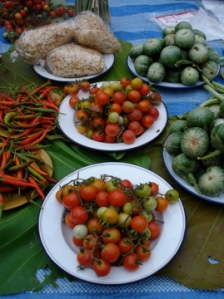
Agriculture in central Thailand has changed tremendously – for Kim-Ang, a leader of the Farmer’s Debt Network – within her lifetime, agriculture has changed from a small-scale producer-based approach similar to northeastern Thailand to an industrialized, export-oriented system. Central to this change has been the irrigation systems developed over the past 20 years. Kim-Ang explained a cycle: seeds are bought and broadcasted, chemical fertilizers are applied, and because the soil is turned over by a tractor 3 times a year, herbicides are necessary to kill weeds as well as pesticides to kill the insects living in the paddies. It is a cycle of high investment costs and debt – “rice has become like people – addicted to chemicals and poisons.” Villagers need to use the government’s SML funds (intended for community development) to buy rice for household consumption – as all rice is sold to mills and after paying off debts, farmers are left with no money to buy rice themselves. Kim-Ang’s Farmer’s Debt Network works to support food security and negotiate debt repayment with farmers in 14 central provinces. Yet land remains in the hands of capitalists, the BAAC or Panit Bank.
Representatives from the Northern Corn Farmers Network – Nan province, southern Thailand’s Fisherfolk Network, the Southern Alternative Agriculture Network, and the Alternative Agriculture Network – Esan gathered on August 20 for a seminar titled “Reforming the Agricultural System for the Development of Farmers’ Rights.” The morning-long event approached the question: Is the farmers’ Congress a space for small-scale farmers of just an opportunity for Agribusiness? Read the rest of this entry »





 Local vendors at the Warin Bus Station market in Ubon Ratchatani – selling local plants on the ground, in front of the dumpster.
Local vendors at the Warin Bus Station market in Ubon Ratchatani – selling local plants on the ground, in front of the dumpster.

